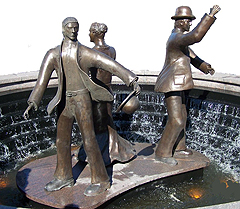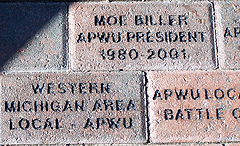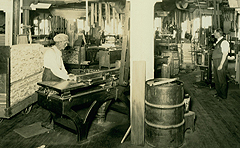The 1911 Furniture Workers Strike
June 30, 2007
(This article was first published in the July/August 2007 issue of The American Postal Worker magazine.)
A century-old and nearly forgotten story about furniture workers who overcame deep cultural divisions to unite for their common good was recently put back in the limelight by a group of labor activists.
“When people think about the union movement in Michigan,” said APWU Western Michigan Area Local President Jennifer Amos, “they usually think about automobile workers in Flint and Detroit.” The 1911 furniture workers strike, however, created a spirit of solidarity that Amos and others say set the stage for many labor gains to come, and that has prompted a civic memorial project to honor that spirit. 
“The strike left a consensus that still exists today,” she said, “that all working people need a fair shake for any community to thrive.”
Seeds of Conflict
After the Civil War, as the nation’s economy became increasingly industrial, German, Dutch, Polish, and other European immigrants flocked to the Midwest. A river city and railroad center with an abundant supply of hardwood forests nearby, Grand Rapids was a prime location for the furniture industry.
By the 1890s, Grand Rapids was the furniture-manufacturing capital of the U.S. One-third of its 90,000 residents were new Americans, most of whom toiled in the woodworking factories. Within the 85 factories, problems augmented by religious and cultural differences caused divisions between skilled and unskilled workers, and between immigrant and the native-born.
The divisions were sharpened when a nationwide industrial slump began in 1905. With furniture workers getting only minimal raises or none at all, the time was ripe for collective action. Instead, the various factions in the 7,000-person workforce turned inward.
They Had Had Enough

Although a workers’ benevolent association had been formed as early as 1886, several attempts to organize the city’s furniture factories had failed. The unionization effort was stymied in part by workers who were content with the status quo, many of whom had mortgages and did not want to upset the industrialists who controlled local banks. In addition, language barriers and traditional Old World bigotry caused distrust, most notably between Roman Catholics and conservative Dutch Christian Reformed Church members.
But with so many of the furniture workers unhappy with their working conditions, a unification effort began in 1910 when a 26-year veteran was fired for leading a small committee of employees seeking a raise.
According to labor historian Michael Johnston, even the most conservative were ready to strike. And on April 19, 1911, 4,000 furniture workers took off their shop aprons and walked away from the job. They asked for a nine-hour work day at 10 hours of pay, the discontinuation of piecework practices, and an end to the firing and blacklisting of union advocates.
A Company Town
The furniture company owners were not pleased with the challenge to their authority, and refused to talk with the workers or their United Brotherhood of Carpenters and Joiners representatives. Leaders of the Grand Rapids Furniture Manufacturer’s Association pressured banks to foreclose on striking workers’ mortgages. They targeted leaders for retribution, and exploited the well-known divisions among the workers.
 As the strike went into a second month, many strikers had to depend on the good will of their churches and neighbors. Tensions among workers ran high, Johnston said. “But they forged an extraordinary solidarity.”
As the strike went into a second month, many strikers had to depend on the good will of their churches and neighbors. Tensions among workers ran high, Johnston said. “But they forged an extraordinary solidarity.”
Their bond was both challenged and strengthened when strikebreakers arrived in Grand Rapids. Mindful of the potential for a public relations disaster, the carpenters union went to great lengths to curb outbreaks of violence. Although strikers’ wives may have thrown stones at strikebreakers crossing picket lines, in an era when labor strife often resulted in gun battles, not one life was lost during the four-month strike.
To the dismay of the industrial establishment, much of Grand Rapids rallied in support of the workers, including the mayor and the Roman Catholic archbishop. “Although getting a union contract was not an official striker demand,” Johnston said, “both sides knew that unionizing the city’s largest industry was the real issue.”
After a long, hot summer of hunger and want, however, the workers began to weaken in their resolve as the factories remained operational with a workforce of strikebreakers. “Then the Christian Reformed Church issued an edict that union membership was incompatible with church membership,” Johnston said. Facing expulsion, many of the church’s members returned to work. The edict broke the four-month stalemate.
Though the strike failed in many respects, some of the employers did grant wage increases, and the job action is credited with creating a ripple effect in other communities. The strike was a “critical cornerstone of the labor movement in western Michigan,” Johnston told the Grand Rapids Press. These workers put aside their differences to “forge something far greater. That’s the universal idea of the labor movement.”
A Local, Monumental Idea
 In that same spirit of solidarity, unions have come together to honor the valiant furniture workers. In a project spearheaded by Johnston and CWA Local President John J. Egan, a small group of volunteers formed the Labor Heritage Society of West Michigan as a vehicle to educate the community and to raise $1.25 million to construct a monument honoring the strikers.
In that same spirit of solidarity, unions have come together to honor the valiant furniture workers. In a project spearheaded by Johnston and CWA Local President John J. Egan, a small group of volunteers formed the Labor Heritage Society of West Michigan as a vehicle to educate the community and to raise $1.25 million to construct a monument honoring the strikers.
Culminating a more than 10-year effort, hundreds of union members, retirees, and elected officials dedicated the monument on April 19, 2007, the 96th anniversary of the start of the strike. Key supporters included former United Auto Workers President Owen Bieber and Lech Walesa, the first leader of Solidarnosc, Poland’s first free trade union. Walesa, who later became that country’s president, toured the monument site during construction.
“The strike action helped make Grand Rapids a better place,” Bieber said at the ceremony. The monument, he added, “will act as a living tribute to the universal struggle of workers, to find courage to unite and stand for what is fundamentally right. It will also live as a reminder that nothing comes without a price. That hardship turns to resolve. That defeated spirits rise to become victorious souls. That struggle becomes the toil of love.”



